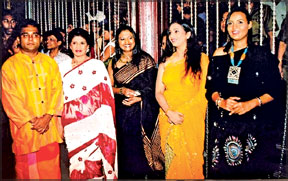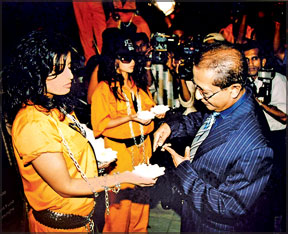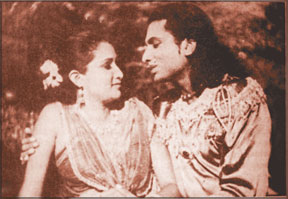|
Projector
Nisala Gira
Premieres at Regal:
THE PREMIERE of the much-anticipated movie, Nisala Gira (Silent
Honour), was held recently at the Regal theatre Colombo. The movie
created ripples in the film industry, featuring an award winning cast
and crew, with a gripping storyline on the challenges faced in today’s
society.
|

Tanuj, Nita, Damitha, Kanchana and Rozanne |
The launch was conceptualised, designed and coordinated by Glenda
Parthipan of Emphasis revolved around the theme colours of orange, black
and white, with a dominant jail atmosphere taken from the storyline of
the film.
Silver chains, along with jail guards and a host of models in Western
themed jail attire, also added to the ambience of the event.
|

Models in Western themed jail attire |
The icing on the cake was when the top actresses starring in the film
Damitha Abeyratne, Kanchana Mendis, Rozanne Diasz and Chandra
Kaluarachchi, handcuffed and dressed in typical Sri Lankan jail attire
took to the streets, parading from Lake House to the Regal theatre. They
were escorted to the event by police guards as well as female police
officers.
|

Mervyn Jayasinghe, Deputy Chairman/Chief Executive Director
the Finance and Guarantee Company (F&G) lights the candle |
The plot of the movie centres around the toll that drugs take on the
lives of people who use them including those dragged in against their
will.
The main character, Radha, played by Nita Fernando undergoes an
excruciating journey, becoming a pawn in an international drug cartel
after the betrayal of her innocence.
|

Former President Chandrika Bandaranaike Kumaratunga arrives
at the premiere |
Framed by a ruthless close family friend, she has to kill her past
before she transcends the obstacles for her inner transformation - of
how she has to bury the ghosts of her past as well as deal with her
husband’s vendetta against the underworld drug kings to walk towards a
new beginning.
Nisala Gira is directed by Tanuj Anawaratne, with the story written
by Yolanda Weerasinghe and international and national award winning
actress Nita Fernando producing the film with the assistance of the
National Film Development Fund.
Mervyn Jayasinghe, Deputy Chairman/Chief Executive Director of the
Finance and Guarantee Company (F&G) sponsored the premiere of the film.
Sri Lankan film industry enters diamond era - Part 4
E. WEERAPPERUMA
Sticking to written form of dialogue, auxiliary stories, advise or
sermon form, getting the actors to when it is not in place, including
inferior comics are some of the examples of the continued features found
in the films that bore the characteristics of the stage plays.
Most of the time the film directors used the actors that played their
roles in the drama, and as these actors had to play their roles in
artificial backgrounds, the films vividly manifested more the
characteristic of stage plays.

These stage-dramas turned films bore the characteristics of the South
Indian cinema, the very vile, rough and rugged inferiority. This was
mainly due to the films being directed by the Indian film directors such
as J.Sing, K.Subramanium, T.R.Gopu, A.S. Nagaragan, T.R.Sundaram. They
produced Sinhala films in cinema studios in Madras like Jemini, Central,
Neptune and Modern Vahini.
The first series of Sinhala films were so immersed and absorbed in
the very vile, rough and rugged inferiority of the South Indian
cinematic form, one of the reputed film critic of the time, Jayawilal
Wilegoda, reviewing the film “Kadawuna Poronduwa”, he wrote that the
South Indian Cinema which speaks in 12 languages has added one more
language to their list. (Tamil films into Sri Lanka - Jayavilal
Wilegoda, Daily News, Page 7, March 27, 1966).
We must bear in our minds that the first Sinhala film screened in
cinema halls in the country, was when Sri Lanka remained a Colony under
the British Empire. At the time people who went for movies were from the
poor working class and from the low middle classes in the cities.
The two category of classes mentioned here were the ardent supporters
of the films screened in our country. It was thought at the time, they
were enjoying films at ease in cinema halls at low economic rate better
than they did in the theatres viewing dramas.
“Asokamala” was the second sound and dialogue film produced in this
country. Shanthi Kumar wrote the script for this film and he was also
the co-director of the film. The story was based on a historical
footing, but failed to bring that out, lucidly.
The well-known Sinhala literati, intellectual of the art and culture
Martin Wickremesinghe commenting on the film said “the film has
destroyed, raped and defiled history”. (Martin Wickremesinghe; Silumina
April 27, 1947). The music provided by Mohammed Ghouse for that film,
his own product, was the only aspect of the film that deserved praise
and appreciation.
The year 1953 was unique in the annals of the Sinhala cinema due to
three principal reasons. It was the year the three films “Pitisara
Kella”, “Kele Handa” and “Sujatha” were produced. Sirisena Wimalaweera
produced “Pitisara Kella” in his own studio “Nava Jeevana” and it was
the first film produced at that studio.
The “Kele Handa” film produced by B.A.W.Jayamanne was the first
Sinhala film based on a novel. “Sujatha” directed by T.R.Sundaram was
the first film production of the Cinemas Company.
There were also films like “Divya Premaya” (Laila Mitral); “Prema
Tharangaya” (Nava Jeevanam), a sort of a reproduction of the Tamil and
Hindi films. But the film “Sujatha” was the classic example of the
mimicry of the Tamil and Hindi films and at the same time, which
established the parody in the Sinhala cinema that was to follow.
The film “Sujatha” was a scornic reproduction of the Hindi film “Bari
Beheth”. Karunasena Jayalath, a well-known film critic of his time
commenting on the film in a latter stage said: “one was able to call it
a Sinhala film, solely because the actors in the film were tete-a-tete
(taking) in Sinhala. (Lankadeepa; page 4, August 19,1980).
According to film critique the ‘vattoru’ cinema (birth of dossier)
began with “Sujatha”, the Sinhala film, financially, a highly successful
cinematic creation. It had its influence over the other films to such an
extent, films that followed “Sujatha”, had songs, fights and comic as a
must, to be a financially a successful film.
To the businessmen who entered into the cinema field with the sole
purpose of earning more money, “Sujatha” stood as a beacon, a roll model
and anchor of hope.
For this reason it was an accepted fact even by the film critiques of
the time, that if one were looking for financial success in entering the
filmdom, then the films they produced had to be copies either of the
Tamil films or Hindi films.
The wave was so strong the country saw the emergence of duplicating
class. The films that came from these groups were “Ahankara Sthri” (Wellaka
Aghal), “Duppathage Duka” (Walepi Padumpaadu), “Mathalan” (Engamma
Sabatham), “Sundara Birinda” (Wangithotte Walipan), “Ramyalatha” (Devadas),
and “Mangalika” (Kallatur Kannamma). Some producers found more plausible
ways and other options. That was to graft Sinhala dialogue to Tamil and
Hindi films.
The films “Salli Epa” (Milaj), “Manushyathwaya” (Insant),
“Pathiwatha” (Devatha), “Aiyayi Malliyi” (Buri-Buri),” Sudu Nangi” (Boti
Beheth), “Ahinsaka Prayogaya” (Mismari) bring out very clearly how they
manipulated the opportunity to make the best for their own advantage.
And this is the reality.
The wave of protests and denouncements that followed condemning the
copying or imitating the Tamil and the Hindi films and grafting Sinhala
dialogue to these films let the governments then in power to prohibit
going to India for the production of Sinhala films and dubbing Sinhala
dialogue into these films.
This step of the then government should be appreciated as it was the
right thing to do for the well-being and the progress of the Sinhala
cinema. |

